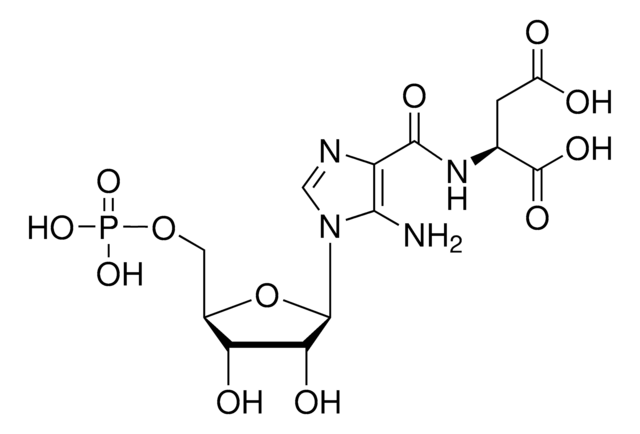06595
5-Aminoimidazole-4-carboxamide-1-β-D-ribofuranosyl 5′-monophosphate
analytical standard
Synonim(y):
AICAR monophosphate, N1-(β-D-5′-Phosphoribofuranosyl)-5-aminoimidazole-4-carboxamide, NSC 283955, NSC 292227, ZMP
About This Item
Polecane produkty
klasa czystości
analytical standard
Poziom jakości
Próba
≥98.0% (HPLC)
aktywność optyczna
[α]/D -69.0±3.0°, c = 0.1 in sodium bicarbonate
okres trwałości
limited shelf life, expiry date on the label
Zastosowanie
forensics and toxicology
pharmaceutical (small molecule)
format
neat
temp. przechowywania
−20°C
ciąg SMILES
O[C@H]1[C@@H](O)[C@H](N2C=NC(C(N)=O)=C2N)O[C@@H]1COP(O)(O)=O
InChI
1S/C9H15N4O8P/c10-7-4(8(11)16)12-2-13(7)9-6(15)5(14)3(21-9)1-20-22(17,18)19/h2-3,5-6,9,14-15H,1,10H2,(H2,11,16)(H2,17,18,19)/t3-,5-,6-,9-/m1/s1
Klucz InChI
NOTGFIUVDGNKRI-UUOKFMHZSA-N
Szukasz podobnych produktów? Odwiedź Przewodnik dotyczący porównywania produktów
Opis ogólny
Opakowanie
Kod klasy składowania
11 - Combustible Solids
Klasa zagrożenia wodnego (WGK)
WGK 3
Temperatura zapłonu (°F)
Not applicable
Temperatura zapłonu (°C)
Not applicable
Choose from one of the most recent versions:
Masz już ten produkt?
Dokumenty związane z niedawno zakupionymi produktami zostały zamieszczone w Bibliotece dokumentów.
Nasz zespół naukowców ma doświadczenie we wszystkich obszarach badań, w tym w naukach przyrodniczych, materiałoznawstwie, syntezie chemicznej, chromatografii, analityce i wielu innych dziedzinach.
Skontaktuj się z zespołem ds. pomocy technicznej








